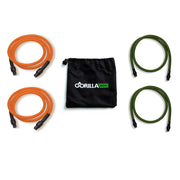How To Boost Your Workout Motivation

Are you looking to make your occasional workout or Saturday Zoom exercise class a consistent part of your routine? Maybe the #stayhome or #shelterinplace challenges have wreaked havoc with your workout regimen and you now must move it from the gym or yoga studio to your basement, closet or bedroom. As you navigate around pets, children and others sharing your household- you may find new your home fitness consistency diminishing. Especially if you have home gym equipment, you likely feel even more guilt when missing workouts, believing you have less excuses for not having completed your strength training, resistance training or total body workout.
We have all heard you have to do something 21 days in a row before it becomes habitual. But, what do you do on the 28th day when you wake up feeling especially tired and more excited for another hour of sleep instead of the exercise you had planned on the night before? Here are 4 ways to make home workouts happen…when you don’t feel like it.
Exercise Motivation Made Easier
Psychologists and economists have been analyzing what compels us to repeatedly do something we don’t always want to do. They have evaluated what helps us override our desire to take the “easy way out” when given the opportunity. Surprise! It’s not all about simply harnessing more will power and increasing your motivation! Here are some of their best strategies to boost workout motivation.
1. Gift Yourself Tangible Rewards
Many people may be motivated by vague goals such as “get healthier” or “lose weight.” But when you aren’t achieving your goals, journalist Charles Duhigg, author of The Power of Habit: Why We Do What We Do in Life and Business suggests making the rewards of working out more tangible, such as treating yourself to an episode of Ozarks or Tiger King, maybe a delicious smoothie. As Duhigg says: “An extrinsic reward is so powerful because your brain can latch on to it and make the link that the behavior is worthwhile.”
In doing this neurological “habit loops”, involving behavior triggers and cues build consistent routines. For example, setting out your clothes the night before cues the routine (making it through resistance training) and then the reward. Duhigg says that “It increases the odds the routine becomes a habit.”
Over time, the motivation becomes intrinsic, as your brain begins to associate sweat and pain with the increase of endorphins, released in the brain that are responsible for that “I-feel-beyond-amazing” rush you get after a fulfilling training session. Once you’ve trained your brain to recognize that the workout itself is the reward, you forget about wanting the treat.
2. Use Resistance Training
Resistance training is an excellent option for all workouts from basic stretching to intense strength training. Especially when compared to traditional weight training methods like machines and dumbbells, resistance band products (like the Gorilla Bow) are lightweight, easy to maneuver, portable and allow you to workout at home, in your yard or anywhere you go (when you are once again, able to go places!). Resistance training gives you a total body workout with Gorilla Bow providing a new and fun way to diversify your workout regimen.
3. Name and Claim Your Goals Publicly
We can make private promises to ourselves all day long, but research shows we’re more likely to execute on pledges when we proclaim them in front of other people, particularly those whose opinions matter to us.
You can increase the stakes even more by signing a contract agreeing to pay a buddy $10 every time you skip a workout. “It’s a simple notion of changing the cost,” explains Jeremy Goldhaber-Fiebert, PhD, assistant professor of medicine at Stanford University who studies health decision science. “I say I’m going to make a commitment to do something for a certain amount of time, such as exercising 30 minutes three times a week for 12 weeks. If I don’t do that, I’m going to pay some kind of penalty, whether it’s monetary or the embarrassment of having friends know I didn’t live up to my word.”
In studies of people who created online contracts via the site Stickk Goldhaber-Fiebert and his colleagues found that those who signed longer contracts ended up exercising more than those who agreed to shorter durations. “We have to get past the initial experience of displeasure in order to recognize the longer-term benefits,” he says. “The challenge is designing tools to help make that happen.
3. Replace Talk with Action
We can make private promises to ourselves all day long, but research shows we’re more likely to execute on pledges when we proclaim them in front of other people, particularly those whose opinions matter to us.
Feel-good fantasies are simply that: fantasies, that make you feel good...until you realize they aren’t going to manifest, unless you take action! But such feel-good fantasies are only effective when accompanied by more realistic problem-solving methods, according to Gabriele Oettingen, PhD, psychologist at New York University and author of Rethinking Positive Thinking: Inside the New Science of Motivation.
“After you imagine the obstacle, you can figure out what you can do to overcome it and make a plan.”
Here’s the entire formula: After identifying your wish and visualizing the outcome, you have to identify what’s getting in your way — a technique she calls “mental contrasting.” In one study of 51 female students who claimed they wanted to eat less junk food, researchers asked each woman to imagine the benefits of eating healthier foods. Those who identified the trigger that made healthful snacking difficult for them — and came up with a plan to reach for fruit when cravings hit — were most successful at sticking to their goal. Feel too tired to workout after work? “After you imagine the obstacle, you can figure out what you can do to overcome it and make a plan,” explains Oettingen. For example, you can switch to morning or lunchtime workouts. Bored by the routine of doing the same strength training program 3 days a week? Begin a resistance training program that complements your other workout regimen.
4. Quaran-teaming for the Win!
While you may be home more now, and even home alone more now- there’s no need to workout alone if you find that diminishes your consistency. Why not get your total body workout with a tribe of others that share similar goals and schedules using technology for connection? Find a home fitness workout regimen that makes you feel good and enables you to achieve your goals and then find your tribe to join you virtually. Whether you have a fully formed home gym or a closet turned shelter-in-place- gym, find your new workout friends and get started. Research shows that working out with others and the healthy actions of others rubs off on us. The research findings don’t dictate that working out has to be in person, so even during this time of social distancing- we benefit from forming our “quaran-team”, maximizing home workout consistency and results!
Get after it!
Photo Credit: Drew Beamer on Unsplash









Leave a comment